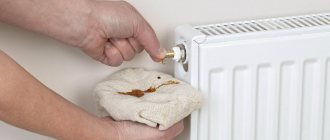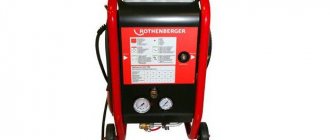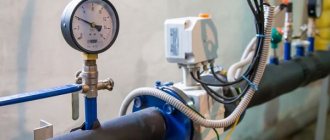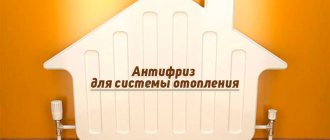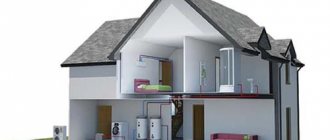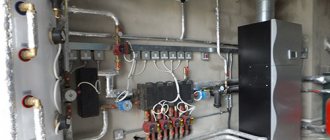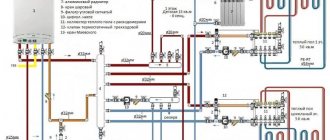How to flush the heating system in a private house
Chemical system cleaning
Chemical washing involves the use of special preparations that may have:
- biological origin;
- chemical origin.
The biological product purification technology is highly effective and environmentally friendly. The action is based on the principle of introducing microbiological agents into the heating system, after which deposits are broken down. This technology does not require disassembling and turning off the entire heating system of the house.
An undoubted advantage of chemical cleaning with biological products is the possibility of painless use in old heating systems. Cleansers are made on a water basis; the preparation serves to separate dirt from the walls. The desired cleaning result is achieved after a few days.
The advantages of this technology are:
- no need to turn off the heating system;
- Possibility of use in old heating systems;
- high efficiency and achievement of the desired result in a few days;
- safety;
- no negative impact on the pipe material.
The mechanism of chemical flushing is the effect of the drug on the contamination of the heating system of the house and cleans it by dissolving sediments and scale. Chemicals act on deposits, which are subsequently removed from the heating along with the liquid flow.
The cost of a chemical reagent depends on the composition and reputation of the manufacturer. The most popular drugs are:
DOCKER TERMO
The cost for 1 liter is 180 rubles; the drug cannot be used for aluminum.
Metalin
The price for 1 liter is 105 rubles; the drug cannot be used for non-ferrous metals.
Master Boiler Power
The price for 0.6 kg is 475 rubles, the drug has no contraindications for use.
Compositions of the SP-OM brand
They have no contraindications for use and can be used with aluminum and non-ferrous metals. The main advantage of the SP-OM brand washing liquid is the ability to use it for washing systems containing polymer components, non-ferrous metals and aluminum. SP-OM is also relatively harmless when draining the used solution. Each SP-OM grade is intended for use with certain metals and under certain conditions. More detailed information about the application and brands of the SP-OM composition can be found on the website https://spomcom.ru/
Significant disadvantages of the method include the difficulty in independently selecting the correct volume of the drug. The possibility of using chemicals is complicated by the fact that in most cases the components of the heating system are made of different materials. Chemicals have varying degrees of impact on metal or polymer materials. In most cases, preference is given to the method of mechanical action on contaminants in the heating network.
Physical cleaning methods
Physical cleaning methods are:
- hydrodynamic flushing;
- pneumohydropulse washing.
For hydrodynamic washing you will need special equipment, including special nozzles and thin hoses.
The cleaning mechanism consists of supplying water under pressure to a nozzle, which is responsible for generating thin jets of water.
The advantage of hydrodynamic flushing is considered to be its effectiveness, but in practice the method is used quite rarely due to its high cost.
Cleaning using the pneumatic-hydropulse flushing method is an effective means of combating contaminants in the heating system. For better cleaning, it is recommended to carry out the procedure several times. The essence of the method is to create increased pressure, due to which dirt breaks off from the walls.
Pros and cons of each method, possible risks
Flushing the radiator with citric acid:
We recommend: Everything you need to know about the operation of the fuel pump in a VAZ 2106 car
Advantages: low cost, high efficiency.
Disadvantages - if you overdo it with acid, it can lead to quite unpleasant consequences - over time, the acid can corrode the rubber and plastic elements of the system. Citric acid is highly aggressive, so you perform such flushing of the heater radiator at your own risk.
Flushing the radiator with Coca-Cola:
Advantages - low cost, speed, high efficiency (Coca-Cola contains so-called orthophosphoric acid, which effectively fights scale).
The disadvantages of such washing are associated with the gas and sugar content in Coca-Cola. Sugar, which is found in Coca-Cola, can clog the radiator, and the increased state of gases can have a negative effect on the entire system.
Flushing the heater radiator with special means:
Advantages: efficiency, no risks.
Disadvantages - slow action.
Hydrodynamic type of flushing
The heating flushing scheme in this way involves active action of water on scale and deposits. This happens thanks to a stream of water, which is directed under extreme pressure to the desired area.
Water is supplied through special nozzles of the required size and diameter. This type of washing is more expensive than chemical washing, but the result is much more satisfactory.
Scheme of using the hydrodynamic method of cleaning the heating system. Click to enlarge.
This type of flushing is best suited for batteries made of cast iron. Removing scale from cast iron using chemicals is very problematic due to the properties of the material itself, and sometimes even impossible.
However, the hydrodynamic system does an excellent job in such cases.
Another undoubted advantage is the environmental friendliness of such washing, since no acids or solvents are used. But only water.
To achieve the desired effect, specialists must have a special mechanism that will create a pressure of two hundred or more atmospheres.
Naturally, all scale is removed solely by exposure to water. No additional liquids or reagents are needed.
But here, too, everything is not as simple as it seems. Before flushing using this method, you must take the radiator to a service center. There it will have to be treated with a special liquid so that the layer that needs to be removed becomes softer and more pliable.
Only after this can the walls be treated with a jet of water operating under pressure. Using this method, you can remove almost everything: grease, scale, rust, dyes, carbon deposits, etc.
When the system should be cleaned
The system will require an initial flush after installation to remove any remaining flux or pipe joining material, as well as any metal particles such as swarf left over from recent installation or changes to the piping.
If the system is properly maintained, well designed, and regularly treated with a corrosion inhibitor, unscheduled flushing is unlikely to be required unless significant changes are made to the system.
However, not all of these requirements are common and sludge can build up in the system very quickly. Here are a few clues that indicate that sludge has already begun to accumulate in the heating system:
- cold “spots” on the bottom of radiators;
- parts of the heating circuit that do not heat up correctly;
- Excessive noise (bumps, clicks, pops) made by the boiler when it heats up.
The heating circuit should also be thoroughly flushed before installing a new high-efficiency condensing boiler, as the heat exchangers in such boilers are particularly susceptible to damage from contaminants in the heating system.
General information
Before cleaning, you should check the system to determine its configuration. You also need to determine the “age” and general condition of the components in order to select the required system flushing mode. For example, the procedure may remove corrosive debris blocking openings in radiators, which can lead to coolant leaks. If there is any doubt as to whether the system will withstand any cleaning methodology, replacement or repair of the relevant components will be required before proceeding.
Cleaning procedure
There are several ways to clean a system and there are a number of cleaning products on the market designed to help flush heating systems. Many products are designed to be added to the circulating water some time before flushing and help mobilize contaminants prior to flushing. Here you need to follow the instructions from the manufacturer of these products.
Basic flushing procedures:
- Powerflushing.
- Overpressure flushing.
- Flushing with a circulation pump
Positive pressure flushing is probably the most effective procedure (although it is important to check the boiler manufacturer's instructions to determine whether flushing the system using the boiler in the heating circuit is acceptable). Powerflushing is also an effective method for cleaning heating systems, especially those containing high levels of black magnetite sludge. Powerflushing is also an effective method for cleaning heating systems, especially those containing high levels of black magnetite sludge.
Powerflushing is also an effective method for cleaning heating systems, especially those containing high levels of black magnetite sludge.
Please note that with all methods, changing the direction of coolant flow will help remove debris that could otherwise remain in the system and cause it to fail.
Preparation
Before flushing with any method, there are several general preparation steps. Typically these involve adding a suitable detergent to a running heating system and letting it sit for some time before actually flushing. The cleaner is usually flushed (while hot) from the system and the system is primed to begin the final flushing process.
Before flushing, you may also need:
- Turn off all electrical controls and electrically isolate the system.
- Avoid supplying cold water to the central heating system.
- Manually close all heating circuit vents.
- For systems with open ventilation, close or temporarily connect the open ventilation and cold water supply to the supply and expansion tanks.
- When draining a vented system, the collection tank may have quite a large portion of floating sludge. It must be removed to prevent it from being drawn into the pipeline.
- Mark the operating position of any shut-off valves or other control valves, and then open all valves fully.
- Remove all thermostatic radiator valve (TRV) heads to ensure maximum flow through the valves.
- Set any diverter or zone valves to their manual open position.
- Where check valves are present, they must be closed, bypassed or temporarily removed, otherwise this will prevent flow reversal.
Cleaning cast iron radiators is not a problem
Rinse the cast iron heating radiator, as it is heavy, which in itself is inconvenient. In addition, due to the design features, it silts heavily.
To remove a cast iron battery you will have to work hard - as a rule, the connecting couplings and taps are rusted, so it will be difficult to unscrew them. Start by draining off any remaining water. To do this, unscrew the plug at the top, place a basin or other container under the bottom and begin to unscrew it easily.
We recommend: How to make air heating of a private house with your own hands - diagrams, photos and videos
Important!!! On cast iron radiators, the plugs can be with either left-handed or right-handed threads.
If the plugs are painted, use solvent or White Spirit to remove the paint from where it connects to the section. After that, try to unscrew it with a gas wrench. If it does not flow, use a rust converter, for example, WD-40.
When the remaining water has been drained, it is necessary to disconnect the cast iron radiator from the common line. Usually it is mounted on special couplings (see photo). As with plugs, couplings can also become rusty. Instead of couplings, valves, taps or fittings can be installed. In this case, you will need to unscrew them.
Such couplings usually connect pipes in heating systems with cast iron radiators.
It is best to wash a cast iron battery in a bathtub, which must be completely covered with rags or rags so as not to damage the enamel coating or acrylic.
First, clean the bottom and top using rags. You may need something like a metal rod to remove any stubborn dirt, especially at the bottom.
After this is done, you need to tighten the plugs at the bottom of the cast iron radiator and pour liquid or flushing solution into it. Let it sit for as long as required by the rules of use, then drain it by unscrewing the bottom plug.
Screw the cap back on at the bottom and fill all sections with hot water. Let it sit for 3-5 minutes and drain. Repeat the procedure until the water coming out is as clean as the water coming in.
The level of contamination of cast iron radiators is higher than bimetallic and aluminum ones. Therefore, repeat the cleaning procedure again. You may have to do this 3-4 times.
Battery flushing
It is most convenient to wash batteries in large containers . Considering the low weight of the products, the best option would be to process the equipment in a bath. The first cleaning is carried out without the use of chemicals . The radiator is filled with water and dirt is mechanically removed from it using shaking.
The spent contents of the device should be poured out , and special reagents should be poured . The solution is kept inside the battery for about an hour , after which the equipment is knocked with a wooden hammer or shaken to remove any remaining rust and dirt. At the end, the device is rinsed in running water .
Compressor for washing: means and equipment, reagent
When choosing equipment, familiarize yourself with the characteristics and features of the heating circuit
Pay attention to the size of the heating system and how many heating devices are installed in it
There are other parameters that affect the compressor installation.
Often, specially prepared coolant is poured. In this case, the pipeline will remain in normal condition for a long time. But this happens rarely, and usually ordinary running water is poured in, containing salts of microelements, which gradually settle on the walls. A simple example is a kettle with scale that has formed.
In addition, silt and dirt accumulate inside, and rust forms. A number of problems arise:
- Reduced heating quality. Since salt layers have low efficiency, they become an obstacle to the transfer of thermal energy to radiators.
- Due to the reduction in the internal diameter of the pipes, the passage of coolant becomes less intense.
- Any type of pollution helps reduce the operating period of heating.
After such problems occur, coolant circulation deteriorates. This is reflected in a decrease in air temperature in the heated room.
The best preventive measure to combat this problem is regular cleaning of the circuit. Cleaning methods:
- Using chemical reagents that can dissolve dirt and scale.
- Jets of liquid supplied under high pressure wash away the plaque on the inside.
- Using the hydropneumatic pulse method.
Compressor for hydropneumatic flushing of the heating system
The compressor is connected using hoses. First, a thorough analysis of the structure is needed to identify areas that are severely affected by layers.
Then the compressor operating mode and cleaning method are selected.
Hydropneumatic flushing is performed in the following ways:
- Filling the circuit and supplying compressed air under pressure. After the procedure is completed, the drain valve opens.
- Flow-through method: water is supplied continuously.
In order to protect the receiver from liquid entering it, a check valve is used.
The device is turned off and dismantled. The results are checked: a small section of the pipe is cut off, with a clean inner coating.
Models are top sellers
Popular brands of washing equipment:
- Ropuls. The compressor cleans heating appliances, water pipes, heated floors and solar collectors. Among the advantages is the disinfection of drinking water.
- Rockal. Small heating cleaner (no more than 300 l).
- Cillit-Boy. Universal equipment: with its help, heating circuits, hot water supply and hot water supply pipes, drinking water pipelines and the “Warm Floor” system are freed from dirt. Controlled by an electronic module.
The supply of compressed air with liquid is under pressure. This loosens all the accumulated layers.
Preparation for major flushing
To clean the interior heater radiator directly on the car you will need:
- There are two types of detergent – alkaline and acidic;
- standard set of keys, screwdrivers and pliers, funnel;
- a low-power water pump (a household circulation unit for heating and an electric pump from a Gazelle truck are also suitable);
- two hoses 2 meters long with tightening clamps;
- distilled water in an amount of 3 volumes of the cooling system of your car;
- boiler and bucket;
- old nylon tights or gauze folded in three.
Also prepare a container for draining old antifreeze and the required volume of fresh coolant. Often, car enthusiasts wash the heat exchanger of the stove without completely emptying the pipelines and engine jacket, but then all the debris contained in the old antifreeze will again flow into the clean radiator.
It is more convenient to carry out work in a garage equipped with an inspection ditch. To remove deposits without removing the heater from the car, completely drain the antifreeze from the engine in the following order:
- Allow the engine to cool to room temperature and place a container underneath for antifreeze.
- Unscrew the plug on the cylinder block with a wrench, then open the cap of the expansion tank.
- When all the antifreeze has flowed out, screw the plug back into place. If the main radiator has a second drain, repeat the operation.
- Disconnect the pipe at the highest point of the system - on the throttle valve or carburetor heating unit.
On some cars, emptying is prevented by covers that protect the engine compartment from dust from entering from below. There are 2 options to solve the problem: remove the protection or use a long hose attached to the neck after unscrewing the plug.
We recommend: How to replace brake discs on a VAZ-2114 yourself
How to flush your heating system
Before you start washing, you should prepare the necessary materials and tools for work. Since special equipment for cleaning pipes is quite expensive, and their use requires certain knowledge, you can purchase cheaper material.
For self-washing you will need the following material and tools:
- A container for draining liquid from pipes.
- Rags, old rags.
- Keys.
- Gas-burner.
- Kerosene lamp.
- Hose to match the diameter of the hole in the pipes.
- Iron brush.
After all the material has been prepared, you can begin to wash the battery.
Rent of washing cleaning equipment
| WE OFFER EQUIPMENT WASHING UNITS FOR RENT | |
| Using this pumping station, you will be able to service a hot water boiler, remove lime deposits from the heat exchanger, and also perform comprehensive maintenance of heating systems, air conditioning systems, chiller refrigeration systems, vertical industrial water heat curtains, water boilers and other equipment requiring servicing, underfloor heating system , water heat pumps, industrial reverse osmosis systems. Our pumping station has pump protection against dry running, as well as automatic pump control, which makes it more practical and convenient when working on cleaning heat exchange equipment. IN CASE OF ANY DIFFICULTY, OUR SPECIALISTS CAN GO TO YOUR SITE AND CARRY OUT MAINTENANCE WORK. | |
| CHEMICAL CLEANING OF THERMAL POWER EQUIPMENT | |
| TECHNICAL CHARACTERISTICS OF THE PUMP GEL BOY C 190 | |
| Electric motor 220 V – Hp 0.75 | |
| Connected power W 559.5 | |
| Head height, max. m in.st. 22 meters | |
| Max, circulation rate 150 l/min (9000 cubic meter per hour) | |
| Protection type IP 54 | |
| Capacity volume 100 liters | |
| Amount of acid to be filled, max, l Measuring lines | |
| Temperature, max. 50°C | |
| Empty weight 14 kg | |
| Centrifugal pump | |
| RENT FULL SET 15,000 TR with VAT PER DAY | Overall dimensions, Width 53 cm x Height 72 cm |
| Number of hoses 2 pcs. | |
| Connection inches 1 Inch (25mm) | |
| With additional equipment - a complete set of washing equipment may include: | |
| 1. Installation for washing heat exchange and boiler equipment2. A device for measuring the pH of a solution, range 0-14 ph - for measuring the pH of the washed solution3. Pump for pumping chemical liquids from a canister4. Consultation in the selection of a reagent, neutralizer, passivator, etc. | |
| HYDRODYNAMIC CLEANING OF THERMAL POWER EQUIPMENT | |
| Compressor for flushing Rothenberger Ropuls drinking water systems with a pulsating water-air mixture in accordance with EN 806 and DIN 1988 part 2, as well as dirty floor heating systems and water heaters. | |
| TECHNICAL CHARACTERISTICS ROTHENBERGER ROPULS (ROPULS) | |
| Pipe connection: R 1″ Geka coupling | |
| Maximum pipe diameter: DN 50/2″ | |
| Maximum water flow: 5 m3/h | |
| Maximum water pressure: 7 bar | |
| Maximum water temperature: 30°C | |
| Protection degree: IP 22 | |
| Oil separation rate: 99.9% | |
| Particle filtration: 0.3 micron compressor | |
| Maximum operating air pressure: 8 bar | |
| Motor power: 1.5 kW | |
| Power: 230 V - 50 Hz | |
| Dimensions (H x W x D): 630 x 380 x 340 mm | |
| RENT FULL SET 15,000 TR with VAT PER DAY | |
| PORTAFLOW 220A LIQUID FLOW METER | PORTAFLOW 330 LIQUID FLOW METER |
| PRINCIPLE OF OPERATION OF THE DEVICE: When ultrasound is transmitted through a liquid, the speed of sound propagation in the liquid increases slightly if the sound is transmitted in the same direction as the flow, and decreases when propagating in the opposite direction. Therefore, the difference in the time of sound propagation over the same distance in the forward and reverse directions will be directly proportional to the speed of fluid flow. | |
| RENT FULL SET 15,000 TR with VAT PER DAY | RENT FULL SET 15,000 TR with VAT PER DAY |
| Read more >>> | Read more >>> |
| PRESS TONGS FOR METAL-PLASTIC PIPES VALTEC (VALTEC) | LASER INFRARED THERMOMETER -50 ~ + 280 |
| FULL SET 500 TR PER DAY | FULL SET 150 RUB PER DAY |
| Read more >>> | |
| SALE OF NEW EQUIPMENT 1500 TR | |
| DEVICE FOR MEASURING PH SOLUTION RANGE 0-14 PH | PUMP FOR PUMPING ACID TO ALKALI FROM A CANISTER |
| FULL SET 100 RUB PER DAY | FULL SET 300 RUB PER DAY |
| SALE OF NEW EQUIPMENT 800 RUB | SALE OF NEW EQUIPMENT 1500 TR |
Equipment types
Timely cleaning of the system allows you to get rid of problems such as rust, scale and sediment. There are several types of heating system flushing equipment used for varying degrees of system blockage.
Hydroflushing
This method involves supplying compressed air and water to the heating system. High pressure and frequent pulses allow small air bubbles, which actively fill a separate section of the system, to quickly and effectively separate deposits on the walls.
To achieve maximum effect, cleaning takes place in separate, relatively small areas (for example, one riser). Before starting the cleaning process, you should determine the amount and speed of water required for cleaning, as well as the amount and level of air pressure. When making calculations, it is necessary to take into account both the length of the section of the system selected for flushing and the diameter of the pipes used in this section.
Hydroflushing of heating systems can be carried out in two ways - flow and filling. The flow-through method involves completely filling the heating system with water. In this case, the air collector valve must be open. After the system is filled as much as possible, the valve closes and the compressor begins supplying compressed air to the system. Hydropneumatic flushing of heating systems ends when exclusively clean water without impurities begins to flow from the open pipe. For further operation, the system must be cleared of the water-air mixture.
First of all, the area of the system selected for cleaning should be filled with water. Next, the air collector valve closes. After this, the supply of compressed air begins through the second valve. You should first check the level of contamination - the duration of the air supply depends on it, as well as on the length of the area being cleaned. After stopping the air supply, it is necessary to close the shut-off valves. Next, the mixture of water and sediment formed in the system should be drained into the drainage. After using this method, the system must be flushed several times with water.
Process description
During washing, dirt, deposits, limescale, scale, and rust are removed. To ensure successful cleaning, a number of calculations and preliminary steps are performed:
- Pipeline parameters: length, diameter.
- Air flow and pressure.
- Carrier speed and pressure.
- Measurements of individual groups of risers.
- Checking the presence of shut-off equipment.
- The need to add chemicals for older systems.
- Dismantling equipment that may be damaged by high pressure.
If the pipeline length is short, pipes are inserted at the inlet and outlet. The first is needed for reverse movement, the second is used to drain dirty water. If there are large lines, pumps are connected to the operation to increase the speed of the carrier and in case of insufficient compressor power. There are two methods of hydropneumatic flushing of the heating system:
1. Filling method.
The technology is considered quite complex, since the process involves filling with liquid, then compressed air is supplied every 15 minutes. A compressor is involved in the work. Using water hammer, deposits are removed from surfaces and dirt is lifted from the bottom of the radiators. The coolant with impurities is released through the drain valve of the system. Washing is carried out in several stages until the equipment is completely free of scale. The method is very effective, but difficult to implement, so it is better to entrust the processing to specialists.
Cleaning the heating system involves simultaneously pumping liquid and air through all areas. Before supplying water, it is necessary to close the collection valve; when the compressor is running, unscrew the drain pipe. Passing through all pipes and appliances, the mixture cleans them and then drains. The procedure is carried out continuously until clear liquid comes out. In difficult cases, when washing, chemical reagents are included in the cleaning mixture. An alkali or acid is added to the water, which can dissolve the deposits. Work can be carried out without the participation of a compressor; dirty water comes out when the pump is connected. The amount of funds depends on the length and diameter of the system elements. The method is considered fast and effective, but is not suitable for washing aluminum units, as there is a risk of destruction of the walls from chemicals.
We recommend: Gas boiler in the kitchen: installation and installation rules, how to hide a gas boiler in the kitchen
Pressure testing is carried out after cleaning the heating pipes using the hydropneumatic method. The procedure is necessary to identify defects and lack of tightness as a result of washing. The system is filled with water at a slow pace, while the operating pressure should be from 2 to 8 atmospheres, depending on the number of storeys of the house. The parameter is saved for half an hour and checked by connecting a pressure gauge to the inlet pipe. If the meter shows the minimum value, there is a leak that is found and repaired. To do this, drain the water, make repairs, then refill the system until the pressure gauge readings improve.
Cleaning heating pipes using hydropneumatic flushing is a requirement in preparation for the season. Unfortunately, the frequency of the procedure is not always observed, which often leads to equipment failure and an accident on the highway. After choosing a method of implementation, it is necessary to agree with specialists about crimp testing. This will help identify possible defects and places of depressurization.
Devices used
Pipeline cleaning can be done in different ways, and a specific unit is selected for each of them. The price of some devices can be quite high, since their efficiency is at the proper level. Some work can be done with your own hands using inexpensive tools.
Hydrodynamic installations
The main equipment is water jetting machines that supply liquid under high pressure. With their help, it is possible to eliminate deposits in pipelines with a diameter of 20 mm and above. The high efficiency of the method is achieved through the use of special nozzles.
Compact size water jet.
Hydrodynamic technology for removing scale and other contaminants is considered the most gentle, since when carrying out work inside the communication system, excessive pressure is not created. This operation is completely safe for installed elements.
Its features are discussed below:
- The advancement of the nozzle is ensured by jet thrust, which is created under the action of high-pressure water flows coming out of the holes in a special nozzle.
- This installation for flushing heating systems works most effectively when using high-performance nozzles. Their choice should be made depending on the nature of the blockage.
- For the most difficult jams, chain carousels and rotary tips are used. The resulting traffic jams in the communication network are successfully removed using punching nozzles.
This is what the pressure cleaning nozzle looks like.
Pneumohydraulic units
The main device is a compressor for flushing the heating system or a pump, which allows the accumulation of compressed air and a sudden release at a certain point in time. In this situation, purification is performed by creating a kinetic impulse in a liquid medium. The swirling water removes deposits from the surface of the pipeline.
The pneumohydraulic design has a special container designed for compressed air, which is usually pumped by a compressor. However, a special pump can also be used to flush the heating system. It is a cylinder equipped with a piston.
One side of the device is in contact with air, and the other with water.
A unit for pneumohydraulic flushing is demonstrated.
- At the very beginning, the device is connected to the heating elements through a switch and adapter hoses.
- After this, water is poured into the system, which enters directly into the cylinder of the main device, moving the piston to its original position.
- Next, the cylinder is charged until the required pressure is created.
- At the main stage, a shock wave is created using a piston, which makes it possible to clean the pipes.
Mechanical impact devices
In this case, flexible shafts with a drive are used, on one side of which metal brushes are placed. The tool that rotates the rod is usually a drill.
The following are instructions describing the procedure for carrying out the work.
The flexible shaft is presented in assembled form.
- At the initial stage, the system is prepared for cleaning activities. The coolant is completely drained, the pipe fittings are unscrewed in the right places.
- A structure is being assembled that will mechanically remove scale and other contaminants from pipelines. A metal brush of suitable size is attached to one end, and a drill to the other.
- Gradually, the flexible shaft is introduced into the interior of the conductive elements of the system. When the device rotates around its axis, scale will fall off the pipe walls.
Electrohydraulic devices
The operating principle of such installations is based on the fact that a coaxial cable is inserted into the liquid medium, which is connected to a high-voltage pulse device. The device creates repeated electrical discharges with a frequency of 1 to 10 Hz. Thanks to this, accumulated deposits are destroyed.
Example of an electrical installation.
Many models of cleaning equipment of this type are capable of cleaning pipelines whose diameter ranges from 10-100 mm. Additional devices may be supplied with the equipment.
Cleaning methods
At the moment, there are several methods by which you can clean cast iron batteries from contaminants. Some craftsmen do all the work at home, while others prefer to turn to heating network workers for help.
We recommend: Choosing the best insulation for walls in a frame house
Each washing option has its own characteristics.
Dry cleaning
Dry cleaning involves everyday cleaning. Cleaning the outside of the battery is not difficult if you do it once a day or at least once a week.
Cleaning heating radiators from the outside:
- The vacuum cleaner comes with special attachments that can remove all the dust between sections if they are very close to each other.
- If you don't have a vacuum cleaner, you can use a hairdryer. We attach a damp cloth between the heating radiator and the wall. We direct the flow of hot air inside the sections and blow out all the accumulated dust. Thanks to the damp cloth, the dirt will not fall onto the carpet, but will stick to the rag. Then we rinse the cloth in clean water and continue cleaning other devices.
You can buy a special brush for heating radiators in the store. It will be easier for her to wipe off dirt. It is equipped with soft sponges that are very dense and allow you to clean the battery from several sides at once.
Wet cleaning
Use any detergent that can be used to clean the outside of a cast iron radiator.
Mix some liquid in a bucket of hot water, whip up foam. Dip the sponge and squeeze out excess water. Wipe the outside of the radiator, and don't forget about the piping and valves.
The wall behind the heating device can also be washed with soapy water.
Mechanical
For such cleaning, the pipes are disassembled. It effectively removes accumulated dirt, but is weakly effective against scale on the internal surfaces of the circuit. Before such flushing, close the valves before and after the boiler, then drain the water from the circuit using a drain valve. If it is not there, unscrew the cap on the radiator, which is located lower and farthest in the apartment. For greater efficiency, after draining the water, the batteries are dismantled.
To disassemble the radiator, use wrenches of the required size, including pipe wrenches. To do this, loosen the union nuts that connect the radiator to the pipes. The radiator is taken outside or into the bathtub, first covering it with thick textiles that protect it from mechanical damage. After washing, the textiles are discarded. The drain in the bathtub is covered with a mesh to prevent clogging of the sewer.
They clean the radiator with a cable and use it to clean the pipes. You can remove the primary dirt into a previously prepared container to reduce the load on the sewage system. For greater efficiency, before flushing, you can disassemble the radiator into sections of 2-3. After cleaning, the battery is washed by directing a stream of water into the internal circuit. To do this, use a hose with an adapter, ensuring the tightness of the hose connection. Stop washing when the outlet water becomes clear.
Dispersed
Biological flushing is an improved modification of the chemical method for removing clogged radiators. However, the action of the reagent here is somewhat different from the original method. The diluted reagent entering the system does not destroy the structure of metal radiators: its action is aimed at molecular rupture of the compounds of metal and compressed dirt. This method is applicable to batteries made of different materials, which is convenient and does not cause leakage.
The solutions used are not harmful to humans, so there are no problems with the disposal of waste material. During the washing process, dirt comes out of the batteries in a split form, so its pieces do not clog the radiator and pipe passages. After treatment, a special hydrophobic film is formed on the surface, which prevents the formation of new limescale deposits inside the circuit.
The process is carried out as follows:
- calculate the amount of reagent based on the characteristics of heating systems;
- prepare the device as in the chemical method;
- the device is connected to the system, the pump is turned on, liquid is introduced into the system circuit;
- after the required time, the waste material is drained into the sewer;
- flush the system with water several times;
- the system is filled with clean water.
When performing flushing during the heating season, you need to connect a device that closes the heating system.
Hydrodynamic
This technique involves supplying thin jets of water under high pressure to the heating system. Special nozzles are used for it. Water will not be supplied from a tap using a hose, but through a pump under pressure. Using this method, it is possible to stop the supply hose in particularly problematic areas where flushing is required. The method is considered environmentally friendly and effective for cast iron radiators.
However, it is not so easy to do it at home, because equipment that can provide water pressure of several hundred atmospheres is not cheap. In addition, such washing requires experience, which may require calling a specialist. Another disadvantage is the fact that the deposits must first be softened with a special solution, which is different for each battery material.
Hydropneumatic
This method involves flushing the heating system by supplying high pressure air inside the circuit. It is carried out through the inlet or outlet of one of the radiators, using a compressor, which is connected through a check valve. This connection prevents water from entering the system. The compressor supplies steam, creating a turbulent flow with high energy. This causes the build-up of compressed rust inside the circuit to be torn off and washed out of the system.
To flush radiators in this way, turn off the water. After this, a compressor with a pneumatic gun is connected to the radiator. When the batteries are not dismantled, the cap on the farthest one is unscrewed and a hose is connected through an adapter, which will collect debris. He is taken to the toilet. The first air supply, which is a short-term pulse, is carried out in the direction opposite to the circulation flow of the system.
Re-injection is performed by changing the direction of the air. To do this, the supply and collection hoses are swapped. To make the method more effective, you can dismantle the radiator, although this is more troublesome. The batteries can be taken outside, where it will be easier to wash them. After washing, they are put in place, then the circuit is connected to the coolant and the system is started to wash out any remaining dirt.
Then turn off the water supply, remove the drain hose, and put the plug in place. Now the system can be put into operation. The method is based on shock waves, of which a total of 2 to 5 may be needed. This flushing method does not take more than a few minutes if the radiators are not removed. It does not depend on electricity, since the installation operates autonomously. Its disadvantage is the limited range of action, which depends on the technical characteristics of the air gun used.
Electrohydropulse
This cleaning is carried out using electric discharge energy, which destroys scale and salts deposited inside the circuit. However, the batteries and pipes are not damaged. This method requires special equipment, although its efficiency is high, and the process itself does not require disassembling the heating system. The shock wave will destroy existing scale. And after the process, all that remains is to rinse the system with clean water to get rid of deposits that have lagged behind the walls.
This method is an alternative to replacing batteries. It is based on the application of an electrical charge in water and does not require a large amount of energy. After using a special installation, the heat exchange surfaces are completely cleaned of silt and lime deposits, which increases the internal cross-section of the circuit to the factory size. In this case, you can clean radiators and pipes of any configuration. A coaxial cable with special equipment at the end is placed into the pipe. During operation, periodic electrical discharges are created, which creates powerful waves and hydrodynamic flows, due to which effective cleansing occurs.
We recommend: Do-it-yourself gas heater: options for the best homemade products
Chemical
If you wish, you can clear communications yourself. But this is quite labor-intensive work, the complexity of which is determined, first of all, by the weight of the heating equipment.
During work using the chemical cleaning method, there is no need to violate the integrity of the system - disassemble the batteries into sections. It is most suitable when communications are installed in an autonomous heating system, that is, a private house, cottage or apartment.
The cleaning of cast iron heating radiators itself is carried out using chemical elements - reagents that are sold in many stores. If desired, improvised means can be used, for example, soda ash or caustic soda.
Cast iron radiators can also be washed with composite solutions, alkalis, organic and mineral acids in small proportions. Each container of chemicals has clear instructions to follow during cleaning. The fact is that these elements, with which batteries are cleaned, are aggressive substances. They affect not only scale and deposits, but also the material from which the radiator is made.
To extend the service life of the equipment, it is enough to clean it once every 3-4 years.
Often, when washing on their own, users make a serious mistake - they prepare an acid solution that is too concentrated. A large concentration of the washing solution will easily “eat up” the contaminants, and with them the sealing elements of the device. This may cause the batteries to leak. Chemical liquids should under no circumstances be used to clean aluminum radiators, unless it is a specially designed preparation.
If you lack skills, it is not recommended to carry out the work yourself, otherwise there is a possibility of permanently damaging the equipment. It is best to turn to specialists who have everything you need.
If you still want to do the cleaning yourself, it is not recommended to use too strong substances.
The best options are the salt of ethylenediaminetetraacetic acid or a more gentle option in the form of citric acid.
Hydrogen peroxide
A good helper in the household is 3% hydrogen peroxide. This well-known substance perfectly cleans and disinfects batteries. To use, add ¾ of a bottle to 2-3 liters of water. To remove severe stains, you can use pure peroxide by applying the substance directly to the stained area or with a sponge.
Lemon acid
Using citric acid, you can not only effectively clean the radiator from contamination, but also get rid of the unpleasant odor. As a rule, the smell appears from stagnant water and flower fertilizer that has reached the surface of the radiator. To prepare a cleaning solution, you will need to dissolve 3 tsp in a glass of water. citric acid.
Baking soda
Regular baking soda is suitable for cleaning the battery. To do this, dissolve 2 tbsp in 3 liters of water. l. soda For greater effect, you can add 1 tsp. apple cider vinegar and 7 drops of any liquid soap.
Vinegar 9%
Vinegar is poured into a spray bottle for further spraying onto the stained area, previously cleaned with a damp cloth. Afterwards, the battery must be thoroughly rinsed with water and wiped. Vinegar essence mixed with water in a ratio of 1:10 can also be used. When spraying in the room, the windows should be open; it is better to protect the respiratory tract with a mask.
Use of special compounds
Effortlessly, in just a few minutes, special cleaning products will help remove dirt and grease stains. To remove greasy stains, you can use dishwashing detergents, for example, Fairy, Pemolux, MYTH. Before use, it is necessary to dilute the concentrate in water, foam it and wipe the surfaces of the radiator with a brush or sponge. Light stains can be removed with laundry soap. Complex contaminants can be removed using special household chemicals intended for plumbing fixtures and household appliances, for example, Domestos, Krot, Tiret. Old stains are removed using stain removers, for example, “Vanish” and “Antipyatin”.
Using special equipment
At the moment, there are several types of special equipment used for cleaning batteries.
For domestic purposes this is the following equipment:
- pneumatic pistol "Typhoon";
- device for electrohydropulse influence ZEVS-24;
- Krot-Mini device.
Typhoon
The air gun is a compact and easy-to-use device. Thanks to its targeted effect on blockages, it can clean water and sewer pipes with a diameter of no more than 150 mm.
The essence of cleaning is a hydraulic ram, which, moving at a speed of 1.5 km/h, removes hardened deposits from the walls of the equipment. The maximum distance of the shock wave reaches 60 meters. The use of a pneumatic gun is important if conventional hydraulic flushing does not produce results.
ZEUS-24
Despite its small size, this equipment is powerful enough to destroy hardened deposits firmly stuck to the inner walls of pipes. It can be used to clean products with a diameter of seven to 150 mm.
The working principle is as follows: the device creates an electrical discharge, resulting in a shock wave and powerful hydrodynamic flows. The ZEUS-24 installation allows you to clean hard-to-reach bent and spiral pipes.
Mole Mini
This installation cleans communications with a diameter of 20 to 150 mm - intra-house sewer networks and other pipelines. Thanks to the spiral installed in the drum, cleaning hard-to-reach places is easier.
The device is used in many sectors of human activity: from housing and communal services, hotels, gas stations to industrial enterprises.
Electrical appliances
Thorough cleaning of the battery can be done using electrical appliances. It is important to take precautions.
Vacuum cleaner
You can use a vacuum cleaner for cleaning. It is advisable to use a narrow nozzle, this will allow you to penetrate hard-to-reach places. First you need to remove all dust and debris from the inside, then treat the outside. When finished, you can wipe the radiator with a damp cloth.
Hairdryer
To use a hair dryer, you must first place a towel or any thick cloth soaked in water under the radiator. Direct a stream of hot air onto the radiator. The dust will move from the battery to the damp cloth. Not the most effective way: dirt can remain between the sections, get into the air or walls, floor.
Washing vacuum cleaner
A good alternative to a regular vacuum cleaner. It will cope perfectly even with serious dirt. Cleaning should begin from the inside, and then proceed to the outer surface. A washing vacuum cleaner, thanks to an aqua filter, can prevent the spread of dust throughout the room.
Hydroflushing
The process itself is based on simultaneously supplying water and air under pressure to sections of the pipeline. The resulting mixture cleans the heating system due to the many pulses that the compressor produces to flush the heating system.
Small bubbles form, which gradually destroy various deposits on the walls of pipelines.
Pipes before and after cleaning
Methods
Flow-through. The return and supply pipelines are first filled with water, with the valve on the air collector open. After filling the pipelines, the valve is closed and compressed air is supplied. The air and water mixture is supplied to the pipelines simultaneously (see also the article on hydropneumatic flushing of the heating system). Flushing ends when clean water begins to flow through the nozzle. The water is then drained into the drain. This method is used for flushing hot water supply and heating systems;
Fillings. This method has some consistency in actions. First, the pipelines are filled with water and the valve is closed. Compressed air is supplied to the second pipe for twenty to twenty-five minutes (depending on contamination and pipe diameters). After the air supply is stopped, the shut-off valves are closed and the water is drained through the drain pipe. At the end, the system is washed a couple of times with clean water.
Typical scheme for carrying out work
Hydropneumatic flushing of heating systems with bottom wiring
In heating systems with a bottom heating circuit, flushing is carried out in a similar way. The system is filled with water through valves 19; 24 and 22, while valve 21 is open.
Next, air is purged, starting from the last, of each heating riser. When flushing along the risers, water can be discharged from each riser through tap 23a.
To divert the air-water mixture from several risers at once, the mixture is discharged into the storm drain through drainage 20 (see Fig. 2).
Hydropneumatic flushing of heating systems is carried out until the discharged water is completely clarified.
- After finishing washing, you need to dump the residual water.
- Fill the heating system and perform a one-time reset.
- Next, fill the system with water and take a sample for analysis.
Heat exchanger flushing frequency
If the system does not have a filter, the heat exchanger needs to be cleaned once every 2 years.
The frequency of cleaning heat exchangers is specified in the operating instructions that come with the product. Most manufacturers recommend doing this every 2 years. However, if water saturated with lime is used, a thick layer of plaque can boil in just one heating season, even if the boiler has a stainless steel circuit. When a filtration system is installed in the harness, the procedure can be carried out at intervals of 4-5 years. Water needs to be changed annually, as it changes its structure and acquires properties that are aggressive towards metal.
It is best to calculate the required frequency of cleaning the heat exchanger experimentally. After the end of the heating season, you need to disassemble the boiler, remove the circuit and assess its condition. The plaque will tell you how long it will take for its thickness to reach a critical state.
Tips/Tricks
To increase the cleaning effect, bleach is added to the input. This allows you to disinfect not only water, but also the inner surface of the pipes.
During self-washing, the technician needs to keep in mind that radiators and pipelines are washed separately from the boiler. If communications have a complex, branched structure, cleaning is carried out separately for each circuit.
For preventive purposes, the water is softened, but if this is not possible, the heating system is regularly flushed. Without maintenance, the system quickly deteriorates, and then the owners will have to replace all communications.
How to choose the optimal flushing pump?
Modern washing equipment is represented by units with a variety of functionality. The main manufacturers that have earned the approval of the international market are German factories (Rems, Rothenberger), Italian concerns (Manta Ecologica) and American (RIDGID). But, despite the high quality of each device, it is short-sighted to buy a flushing pump without assessing its operational capabilities. When choosing the optimal model, experts advise studying the specification of the unit.
- For the private sector, preventing and eliminating deposits in the system is a big problem. Utility workers stand guard over the apartment building. In a cottage, the costs fall on the homeowner. The Ridgid DP-24 or DP-13 descaling flushing pump will help the owner deal with the annual problem on his own.
- Inexpensive pumps from Rothenberger compete with compact “Americans”. The popular Rocal and Romatic washing devices do an excellent job of removing scale in installations with a capacity of 300 liters. At the same time, the technical characteristics of Rothenberger and Ridgid units allow the equipment to be used for commercial purposes.
- In the Pump Eliminate model line, professionals will find devices for removing scale from heat exchangers. Any flushing pump from Manta Ecologica is distinguished by high productivity and good throughput. A wide price range and variety of functionality mean you can purchase a unit that meets different tasks.
- Ropuls compressors from Rothenberger are devices on a different scale. They allow you to buy a flushing pump in conjunction with many additional options. In addition to their direct specialty, the units sanitize water pipes, are suitable for testing pressure in the system, and even for connecting pneumatic tools.
- A separate category is pressure testing devices with hydropneumatic pumps. REMS units open up wide scope for the work of specialized enterprises.
